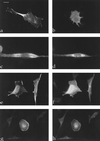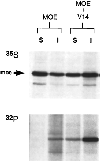RhoA-dependent phosphorylation and relocalization of ERM proteins into apical membrane/actin protrusions in fibroblasts
- PMID: 9450964
- PMCID: PMC25270
- DOI: 10.1091/mbc.9.2.403
RhoA-dependent phosphorylation and relocalization of ERM proteins into apical membrane/actin protrusions in fibroblasts
Abstract
The ERM proteins (ezrin, radixin, and moesin) are a group of band 4. 1-related proteins that are proposed to function as membrane/cytoskeletal linkers. Previous biochemical studies have implicated RhoA in regulating the association of ERM proteins with their membrane targets. However, the specific effect and mechanism of action of this regulation is unclear. We show that lysophosphatidic acid stimulation of serum-starved NIH3T3 cells resulted in relocalization of radixin into apical membrane/actin protrusions, which was blocked by inactivation of Rho by C3 transferase. An activated allele of RhoA, but not Rac or CDC42Hs, was sufficient to induce apical membrane/actin protrusions and localize radixin or moesin into these structures in both Rat1 and NIH3T3 cells. Lysophosphatidic acid treatment led to phosphorylation of radixin preceding its redistribution into apical protrusions. Significantly, cotransfection of RhoAV14 or C3 transferase with radixin and moesin revealed that RhoA activity is necessary and sufficient for their phosphorylation. These findings reveal a novel function of RhoA in reorganizing the apical actin cytoskeleton and suggest that this function may be mediated through phosphorylation of ERM proteins.
Figures










Similar articles
-
Regulation mechanism of ERM (ezrin/radixin/moesin) protein/plasma membrane association: possible involvement of phosphatidylinositol turnover and Rho-dependent signaling pathway.J Cell Biol. 1996 Oct;135(1):37-51. doi: 10.1083/jcb.135.1.37. J Cell Biol. 1996. PMID: 8858161 Free PMC article.
-
Rho-kinase phosphorylates COOH-terminal threonines of ezrin/radixin/moesin (ERM) proteins and regulates their head-to-tail association.J Cell Biol. 1998 Feb 9;140(3):647-57. doi: 10.1083/jcb.140.3.647. J Cell Biol. 1998. PMID: 9456324 Free PMC article.
-
Differential involvement of ezrin/radixin/moesin proteins in sphingosine 1-phosphate-induced human pulmonary endothelial cell barrier enhancement.Cell Signal. 2011 Dec;23(12):2086-96. doi: 10.1016/j.cellsig.2011.08.003. Epub 2011 Aug 12. Cell Signal. 2011. PMID: 21864676 Free PMC article.
-
Cortical actin organization: lessons from ERM (ezrin/radixin/moesin) proteins.J Biol Chem. 1999 Dec 3;274(49):34507-10. doi: 10.1074/jbc.274.49.34507. J Biol Chem. 1999. PMID: 10574907 Review. No abstract available.
-
[ERM (ezrin/radixin/moesin) as crosslinkers between actin filaments and plasma membranes].Tanpakushitsu Kakusan Koso. 1996 Sep;41(12 Suppl):1899-905. Tanpakushitsu Kakusan Koso. 1996. PMID: 8890653 Review. Japanese. No abstract available.
Cited by
-
ARHGAP18-ezrin functions as an autoregulatory module for RhoA in the assembly of distinct actin-based structures.Elife. 2024 Jan 9;13:e83526. doi: 10.7554/eLife.83526. Elife. 2024. PMID: 38193818 Free PMC article.
-
Intrahepatic upregulation of RhoA and Rho-kinase signalling contributes to increased hepatic vascular resistance in rats with secondary biliary cirrhosis.Gut. 2006 Sep;55(9):1296-305. doi: 10.1136/gut.2005.081059. Epub 2006 Feb 21. Gut. 2006. PMID: 16492715 Free PMC article.
-
The cytoskeletal protein ezrin regulates EC proliferation and angiogenesis via TNF-alpha-induced transcriptional repression of cyclin A.J Clin Invest. 2005 Jul;115(7):1785-96. doi: 10.1172/JCI22849. Epub 2005 Jun 16. J Clin Invest. 2005. PMID: 15965500 Free PMC article.
-
Entry of the two infectious forms of vaccinia virus at the plasma membane is signaling-dependent for the IMV but not the EEV.Mol Biol Cell. 2000 Jul;11(7):2497-511. doi: 10.1091/mbc.11.7.2497. Mol Biol Cell. 2000. PMID: 10888684 Free PMC article.
-
Dynamic actin remodeling during epithelial-mesenchymal transition depends on increased moesin expression.Mol Biol Cell. 2011 Dec;22(24):4750-64. doi: 10.1091/mbc.E11-02-0119. Epub 2011 Oct 26. Mol Biol Cell. 2011. PMID: 22031288 Free PMC article.
References
-
- Aktories K, Braun U, Rosener S, Just I, Hall A. The rho gene product expressed in E. coli is a substrate of ADP-ribosyltransferase C3. Biochem Biophys Res Commun. 1989;158:209–213. - PubMed
-
- Amano M, Chihara K, Kimura K, Fukata Y, Nakamura N, Matsuura Y, Kaibuchi K. Formation of actin stress fibers and focal adhesions enhanced by Rho- kinase. Science. 1997;275:1308–1311. - PubMed
-
- Amano M, Mukai H, Ono Y, Chihara K, Matsui T, Hamajima Y, Okawa K, Iwamatsu A, Kaibuchi K. Identification of a putative target for Rho as the serine-threonine kinase protein kinase N. Science. 1996;271:648–650. - PubMed
-
- Amieva M, Furthmayr H. Subcellular localization of moesin in dynamic filopodia, retraction fibers, and other structures involved in substrate exploration, attachment, and cell-cell contacts. Exp Cell Res. 1995;219:180–196. - PubMed
-
- Berryman M, Franck Z, Bretscher A. Ezrin is concentrated in the apical microvilli of a wide variety of epithelial cells whereas moesin is found primarily in endothelial cells. J Cell Sci. 1993;105:1025–1043. - PubMed
MeSH terms
Substances
LinkOut - more resources
Full Text Sources
Research Materials
Miscellaneous

